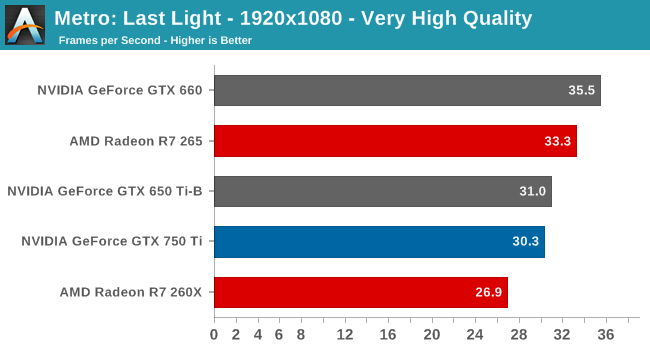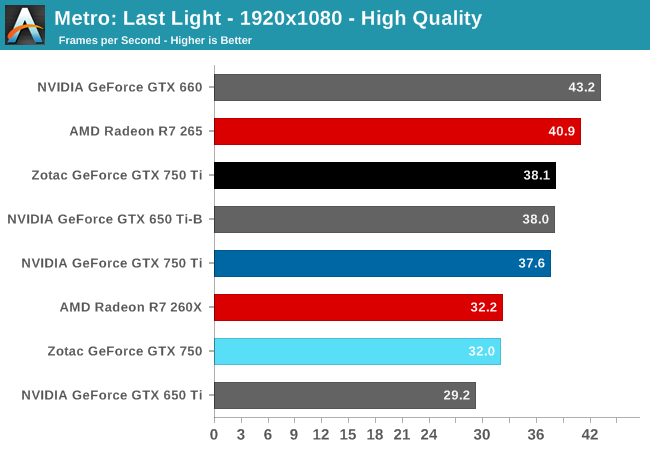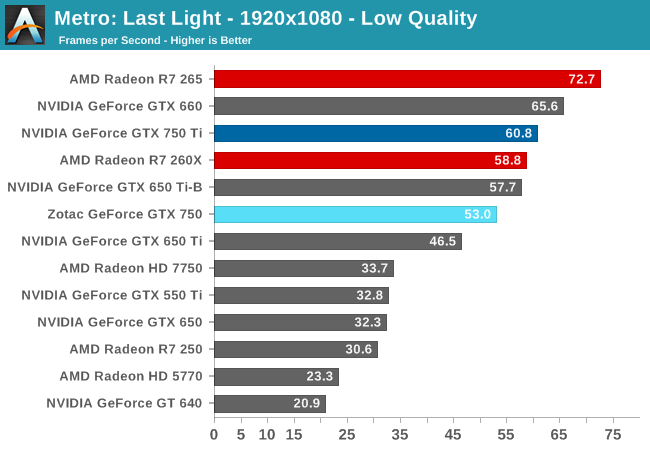The NVIDIA GeForce GTX 750 Ti and GTX 750 Review: Maxwell Makes Its Move
by Ryan Smith & Ganesh T S on February 18, 2014 9:00 AM ESTMetro: Last Light
As always, kicking off our look at performance is 4A Games’ latest entry in their Metro series of subterranean shooters, Metro: Last Light. The original Metro: 2033 was a graphically punishing game for its time and Metro: Last Light is in its own right too. On the other hand it scales well with resolution and quality settings, so it’s still playable on lower end hardware.



Diving into our performance analysis, we’ll be looking at a few different factors. On a competitive basis, the GTX 660 and the R7 265 are the GTX 750 Ti’s closest competitors. Though we’ll also want to compare it to GTX 650, so see what a GK107 versus GM107 matchup looks like. Meanwhile the GTX 750’s closest competitors will be the R7 260X, and to a lesser degree the GTX 650 Ti.
Being one of our more difficult games, Metro shows right off the bat that these mainstream video cards, no matter how fast they are, will face a difficult time. The GTX 750 Ti can stay comfortably above the 30fps at high quality, but the GTX 750 not so much.
What’s clear right off the bat two is two things. The first is that GTX 750 Ti, the GM107 flagship, is significantly faster than GTX 650, the GK107 flagship. GTX 750 Ti is just short of doubling GTX 650’s performance in this benchmark.
The second point is that neither GTX 750 series card is going to fare well against its AMD counterpart. Both the R7 265 and R7 260 are faster than the GeForce cards, and by over 10% at times.
Finally, GTX 750 Ti won’t be touching GTX 660 here. It’s close, but especially at higher quality settings the GTX 660 is pulling away. GTX 750 Ti can’t completely make up for the lack of memory bandwidth and ROP throughput.










177 Comments
View All Comments
RealiBrad - Tuesday, February 18, 2014 - link
If you were to run the AMD card 10hrs a day with the avg cost of electricity in the US, you would pay around $22 more a year in electricity. The AMD card gives a %19 boost in power for a %24.5 boost in power usage. That means that the Nvidia card is around %5 more efficient. Its nice that they got the power envelope so low, but if you look at the numbers, not huge.The biggest factor is the supply coming out of AMD. Unless they start making more cards, the the 750Ti will be the better buy.
Homeles - Tuesday, February 18, 2014 - link
Your comment is very out of touch with reality, in regards to power consumption/efficiency:http://www.techpowerup.com/reviews/NVIDIA/GeForce_...
It is huge.
mabellon - Tuesday, February 18, 2014 - link
Thank you for that link. That's an insane improvement. Can't wait to see 20nm high end Maxwell SKUs.happycamperjack - Wednesday, February 19, 2014 - link
That's for gaming only, it's compute performance/watt is still horrible compared to AMD though. I wonder when can Nvidia catch up.bexxx - Wednesday, February 19, 2014 - link
http://media.bestofmicro.com/9/Q/422846/original/L...260kh/s at 60 watts is actually very high, that is basically matching 290x in kh/watt ~1000/280watts, and beating out r7 265 or anything... if you only look at kh/watt.
ninjaquick - Thursday, February 20, 2014 - link
To be honest, all nvidia did was increase the granularity of power gating and core states, so in the event of pure burn, the TDP is hit, and the perf will (theoretically) droop.The reason the real world benefits from this is simply the way rendering works, under DX11. Commands are fast and simple, so increasing the number of parallel queues allows for faster completion and lower power (Average). So the TDP is right, even if the working wattage per frame is just as high as any other GPU. AMD doesn't have that granularity implemented in GCN yet, though they do have the tech for it.
I think this is fairly silly, Nvidia is just riding the coat-tails of massive GPU stalling on frame-present.
elerick - Tuesday, February 18, 2014 - link
Since the performance charts have 650TI Boost i looked up the TDP of 140W. When compared to the Maxwell 750TI with 60W TDP I am in awe of the performance per watt. I sincerely hope that the 760/770/780 with 20nm to give the performance a sharper edge but even if they are not it will still give people with older graphics cards more of a reason to finally upgrade since driver performance tuning will start favoring Maxwell over the next few years.Lonyo - Tuesday, February 18, 2014 - link
The 650TI/TI Boost aren't cards designed to be efficient. They are cut down cards with sections of the GPU disabled. While 2x perf per watt might be somewhat impressive, it's not that impressive given the comparison is made to inefficient cards.Comparing it to something like a GTX650 regular, which is a fully enabled GPU, might be more apt of a comparison, and probably wouldn't give the same perf/watt increases.
elerick - Tuesday, February 18, 2014 - link
Thanks, I haven't been following lower end model cards for either camp. I usually buy $200-$300 class cards.bexxx - Thursday, February 20, 2014 - link
Still just over 1.8x higher perf/watt: http://www.techpowerup.com/reviews/NVIDIA/GeForce_...